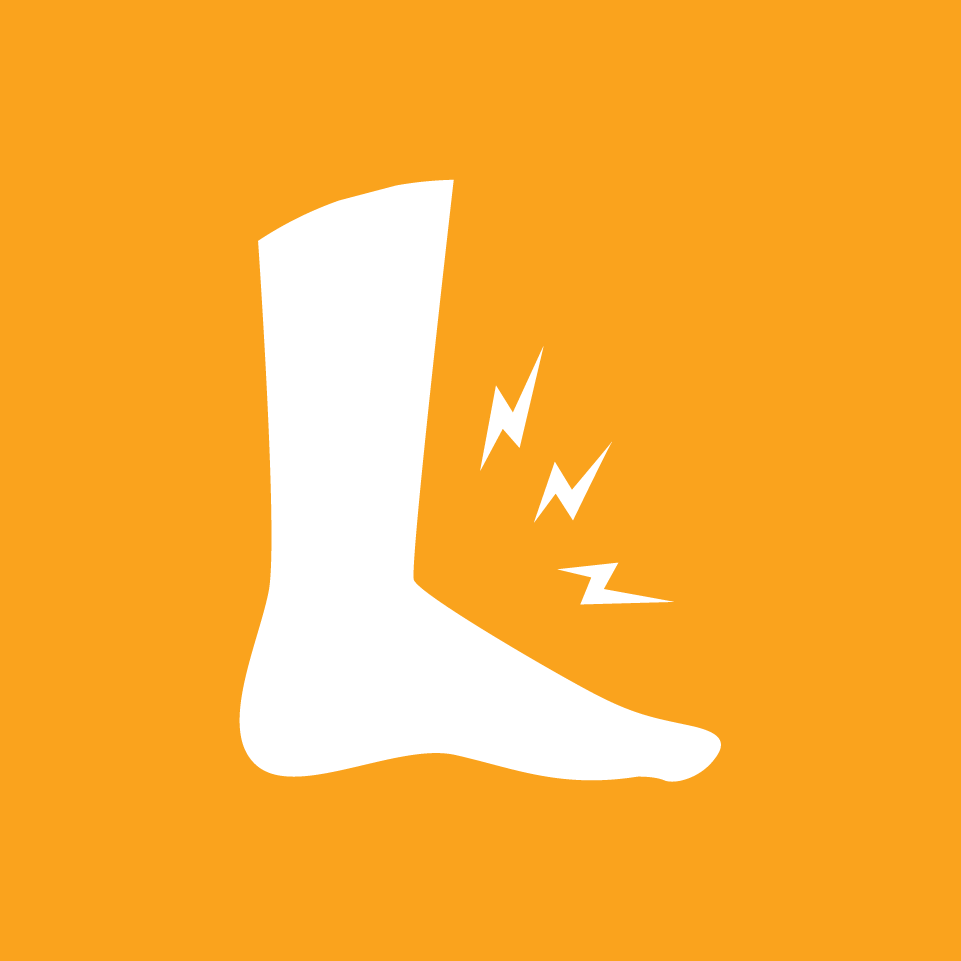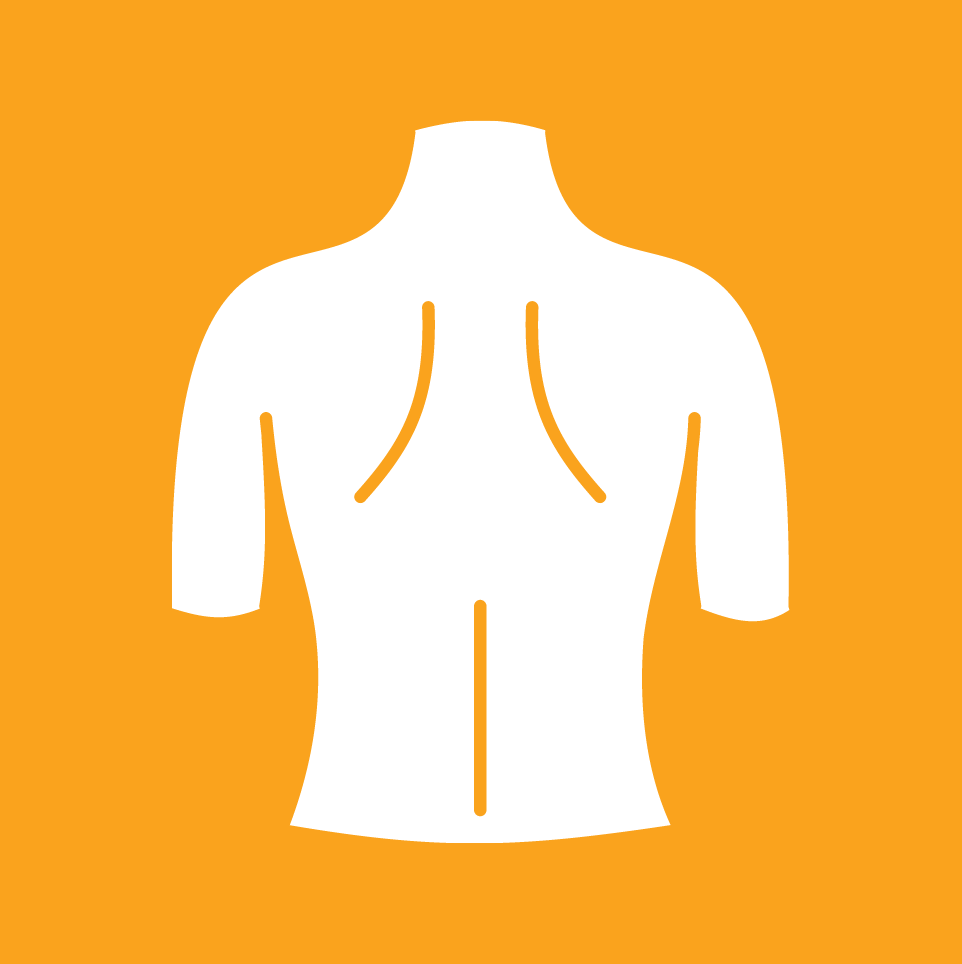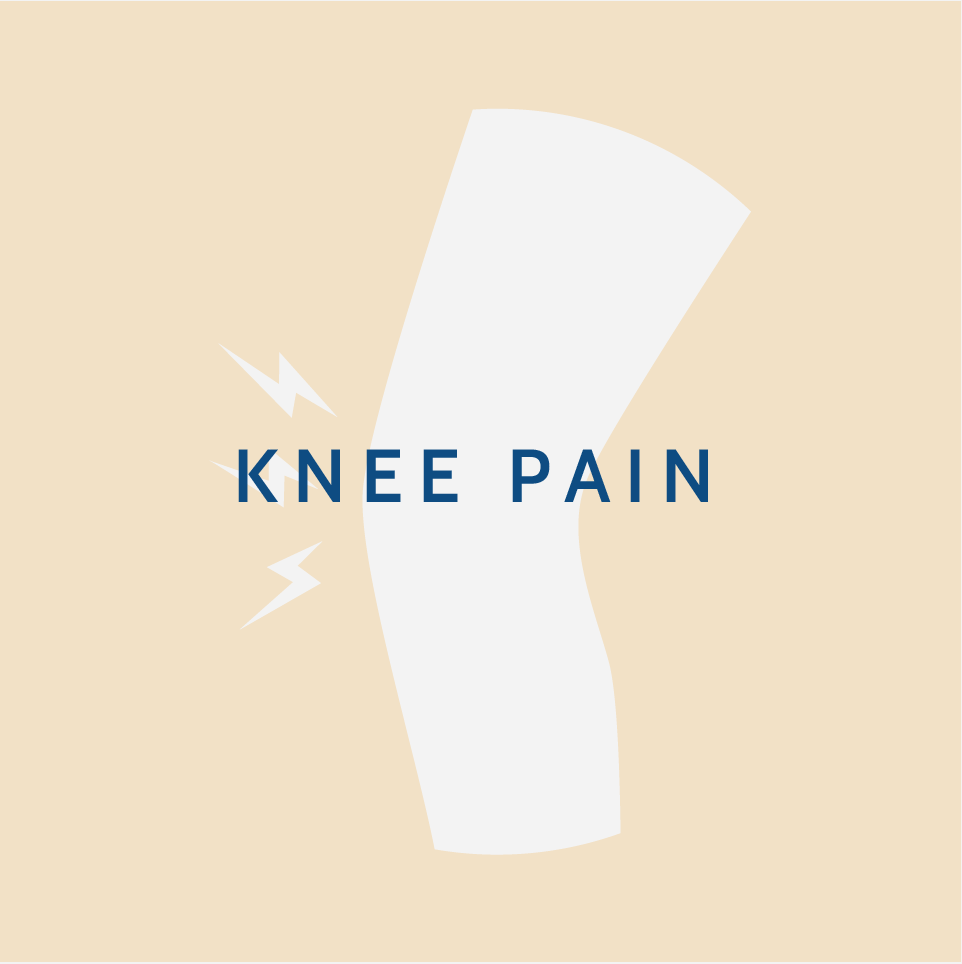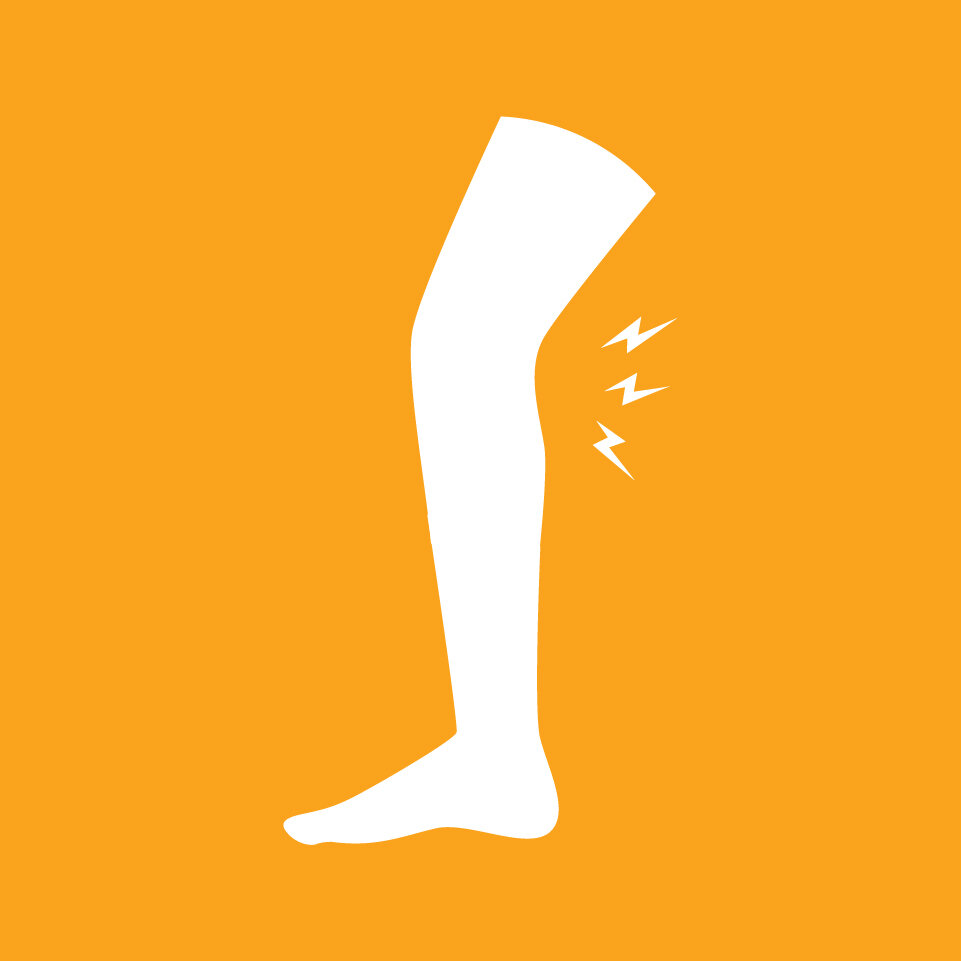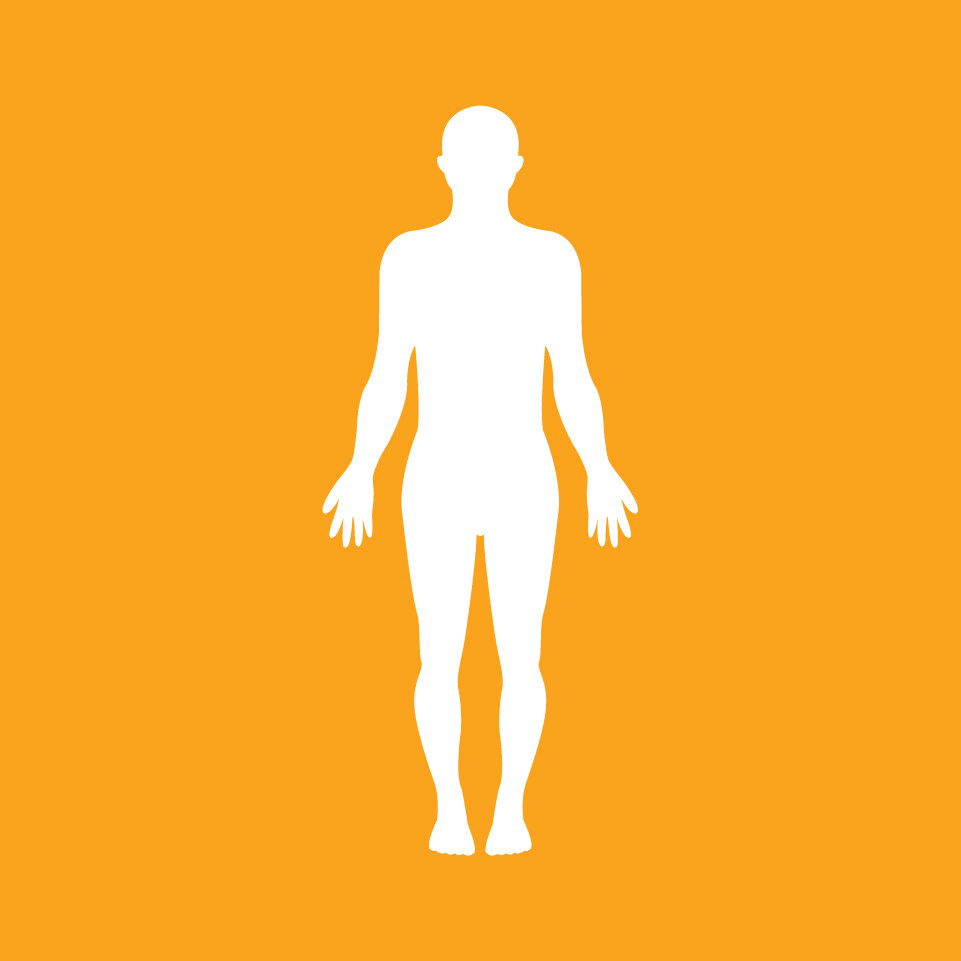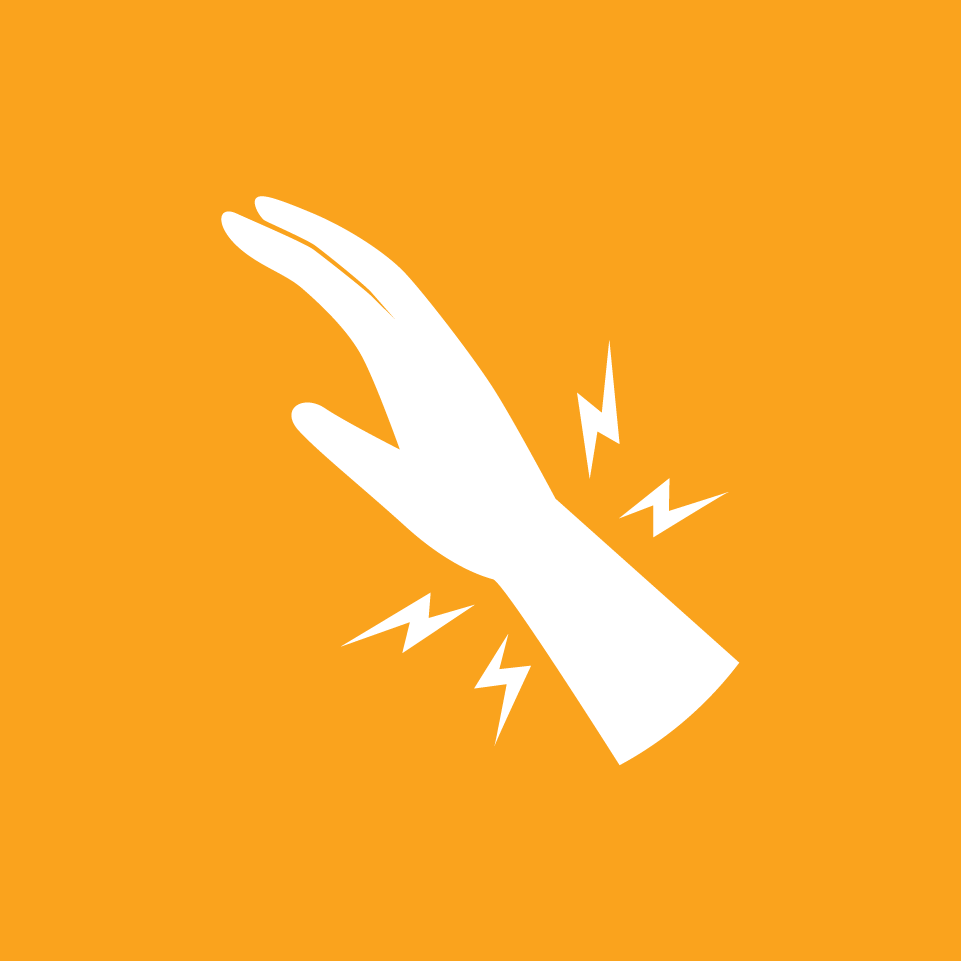Why does my knee hurt?
Knee pain is very common and can have significant effects on quality of life. Both chronic and acute knee pain can hinder your ability to walk and perform everyday functions. Sitting, standing, climbing stairs, exercising, getting in and out of cars, and many other everyday activities can be affected due to knee pain. Injury, strain, or repetitive motion can be the cause of knee pain and many symptoms can result from excess swelling forming in the knee joint.
Where you actually "feel" the knee pain can vary depending on the structure that sustained damage or strain. Locating the exact spot of your knee pain will help in diagnosing the root cause and subsequent treatment. For instance, if you're experiencing pain in your kneecap, commonly referred to as patellofemoral stress syndrome (PFS), it could be due to either poor "tracking" movement of the kneecap in the groove at the end of the thigh bone, or an inflamed tendon located at the front or side of your knee. Pain on the inside of your knee (the side closest to your other leg) could be a result of an injury to the medial meniscus or medial collateral ligament. If you're experiencing pain on the outside of your knee, the root cause could be iliotibial band (ITB) stress, among injuries to various other structures in the knee area. Lastly, pain in the back of the knee could be a result of an injury to (or strain of) the hamstring tendons. If you are able to accurately explain your pain to doctor or physical therapist, it can help tremendously with diagnosing your knee condition.
Symptoms of knee pain:
Redness around the knee joint
Knee swelling
Weak knees
Tender knees
Stiff knees
Excess fluid in knees
Soft kneecaps
Warm knees
Possible reasons for knee pain:
Patellofemoral pain
Patellofemoral pain is pain at the front of the knee, under or around the kneecap (patella). PFP is one of the most common types of knee pain experienced in the United States. It often occurs among athletes, active teenagers, older adults, and people who perform physical labor. Physical therapists design treatment programs for people with PFP to help reduce pain and improve function.
If PFP is diagnosed, your physical therapist will develop an exercise and rehabilitation program just for you. Your program may include:
Strengthening exercises
Taping
Shoe inserts
Coordination training
Cross-training guidance
Osteoarthritis
Physical therapy can be your first line of defense for managing knee OA symptoms. Having knee osteoarthritis can sometimes seem like a double-edge sword. Overusing your knees can worsen your joint health and knee OA, but the less you move your knees, the weaker they can get. You need to find that balance of keeping your knee joints moving just enough so they're strong and healthy, and physical therapy helps you do that. With knee OA, the muscles surrounding the knee can become weak, and the knee joints can become stiff. This makes it difficult to do everyday tasks, such as walking or getting out of bed.
Physical therapy can help to reduce the pain, swelling, and stiffness of knee osteoarthritis, and it can help improve knee joint function. It can also make it easier for you to walk, bend, kneel, squat, and sit. In fact, a 2000 study found that a combination of manual physical therapy and supervised exercise has functional benefits for patients with knee osteoarthritis and may delay or prevent the need for surgery.
Physical therapy can help to reduce the pain, swelling, and stiffness of knee osteoarthritis, and it can help improve knee joint function. It can also make it easier for you to walk, bend, kneel, squat, and sit. The two main types of physical therapy—passive and active treatments—can help make your knee OA more manageable. With passive treatments, the physical therapist does the majority of the work. But with active treatments, you do more of the work, such as at-home exercises.
Rheumatoid arthritis
Rheumatoid arthritis is a chronic inflammatory disease. It affects about 1% of the population. RA often results in pain and inflammation in joints on both sides of the body. In some people, it can become disabling due to its effect on the immune system. Physical therapists help people with RA manage their symptoms and improve and maintain daily activity levels.
Physical therapists play a vital role in helping people with RA improve and maintain function. Your PT will work with you to develop a treatment plan to help address your specific needs and goals, and keep you moving well. PTs understand how bones, joints, and muscles work together. They can help you get your body back on track. Because the signs and symptoms of RA can vary, the approach to your care also will vary. What works for you may not work for others. Your PT will design a treatment plan to meet your needs and may:
Provide advice and encouragement on how to improve your general fitness with regular exercise. As with many conditions, education is key to building and keeping good health.
Design a personal exercise plan to improve your joint flexibility and muscle strength.
Help you develop energy-saving measures to improve your daily functions at home and work.
Suggest short-term, pain-relief methods, such as gentle heat and electrical stimulation.
Tendinitis
Tendinitis is the inflammation or irritation of a tendon; the thick fibrous cords which attach your muscles to your bone. If you have pain or tenderness just outside of a joint, you may be dealing with tendinitis.
Most cases of tendinitis can be successfully treated with physical therapy. Eccentric strengthening has been shown to be very effective for chronic tendon issues, and manual therapy such as certain types of massage can help promote healing. Your physical therapist may even suggest using Dry Needling, which can help reduce muscle tightness around the involved tendons. Education is also an important part of tendinitis treatment in order to correct body mechanics, form and posture to help reduce the strain on a tendon is under stress from daily or repetitive activities.
Bursitis
Knee bursitis, commonly known as "housemaid's knee" and "clergyman's knee," involves swelling of 1 or more of the bursae at the front of the knee. Knee bursitis is one of the most common bursitis conditions; it can be painful when moving the knee, when kneeling, or even when at rest. The condition can also be painless, with only visible swelling present. Knee bursitis can have many causes. The most common is trauma, whether from a direct hit, or the result of activities that require crawling or kneeling on hard surfaces for long periods of time, such as laying carpet or tile, or scrubbing floors. Physical therapists treat individuals with knee bursitis to reduce their pain, swelling, stiffness, and any associated weakness in the knee or leg.
Your physical therapist will work with you to design a specific treatment program that will speed your recovery, including exercises and treatments that you can do at home. Physical therapy will help you return to your normal lifestyle and activities. The time it takes to heal the condition varies, but results can be achieved in 2 to 8 weeks or less, when a proper swelling management, stretching, and strengthening program is implemented. During the first 24 to 48 hours following your diagnosis, your physical therapist may advise you to:
Apply light compression to the area by wrapping the knee a specific way using a compressive wrap.
Rest the area by avoiding any activity that causes pressure or pain in the knee.
Apply ice packs to the area for 15 to 20 minutes every 2 hours.
Consult with a physician for further services, such as medication or diagnostic tests.
Your physical therapist will work with you to:
Reduce Pain and Swelling
Improve Motion
Improve Flexibility
Improve Strength
Improve Endurance
Improve Balance
Restore Agility
Learn a Home Program
Return to Activities
Speed Recovery Time
Dislocated knee
In a normal knee, the patella is positioned inside a groove at the bottom of the femur. A dislocated patella occurs when the kneecap is completely displaced from its normal alignment/position. The most common direction for a dislocated patella is lateral. When this happens, the muscles and ligaments on the inside of the knee become overstretched and damaged. A dislocated patella is primarily caused by a traumatic incident such as twisting or a direct blow to the knee area.
During physical therapy the common goal(s) are to reduce pain and inflammation, especially during ambulation. Another goal is to regain functional range of motion (ROM) as well as improve VMO strength to decrease the risk of the patella from being dislocated again. Physical therapy will also improve patellofemoral alignment by improving muscle and retinaculum lengths. PT will also improve proprioception, agility and balance especially for the active/sports population. Usually, common treatment/recovery time for a dislocated patella is 4 to 6 weeks but this will also depend on the individual. Majority of people with a dislocated patella will recover with conservative treatment and will not require surgery. In some cases, surgery may be required to repair significant bone or ligament damage caused as a result of the dislocation. This may include injury to the medial patella ligaments and muscles, kneecap surface or even performing a lateral ligament release to the knee.
Baker's cyst
If you suffer from knee pain, the culprit might be a Baker cyst, an accumulation of joint fluid that creates a bulge at the back of the knee. The bulge is noticeable, and a physician can usually diagnose it accurately by taking a history and feeling for the swelling behind the knee. Most people will find pain and pressure are their first symptoms. Other symptoms include stiffness behind the knee, swelling and difficulty moving normally. Conservative treatment without surgery is successful for most people. Physical therapy can assist by minimizing the accumulation of fluid and improving the health of your knee and surrounding muscles.
Chondromalacia patella
Problems commonly develop when the patella suffers repetitive wear and tear. The underlying cartilage begins to degenerate, a condition common in young athletes. Soccer players, snowboarders, cyclists, rowers, tennis players, ballet dancers, and runners are often affected but anyone whose knees are under great stress during any work or sport activity is at increased risk of developing chondromalacia patella.
The history and physical examination are usually enough to suspect the diagnosis of chondromalacia patella. Our therapists will question you about your activity level, where precisely the pain is, when the pain began, what you were doing when the pain started, and what movements aggravate or ease the pain. Chondromalacia patella generally begins insidiously (gradual onset) but it can also be instigated by a trauma to the knee, such as a fall onto the kneecap or a hard knock to the knee such as during a collision in sport. Next your Physical Therapist will do a physical examination of the knee and entire lower extremities. They will palpate, or touch, around the knee and particularly along the patella to determine the exact location of pain. They will also move your kneecap to determine how mobile it is and may even try to illicit pain by rubbing on the underside of your patella if your patella is mobile enough to allow this. Your Physical Therapist will look for other factors such as bony alignment (Q-angle,) muscle flexibility, mobility of the patella, and joint laxity that may be contributing to your knee pain. They will want to look at how you stand and your foot position, and may ask to watch you walk, squat, jump or run. Your Physical Therapist will also check the strength and lengths of the muscles surrounding and affecting the knee joint such as the quadriceps, hamstrings, calves, hip flexors and buttocks muscles. All of these muscles, if weak or tight, can contribute to the forces applied to the knee joint and to the development and ongoing pain of chondromalacia patella.
Your Physical Therapist will check if they can illicit pain by providing resistance while you straighten your knee. This action generally reproduces the pain associated with chondromalacia patella because it puts pressure on the painful cartilage on the back of the patella and thus helps to confirm the diagnosis.
Meniscus tear
Meniscal tears are common injuries to the cartilage of the knee that can affect athletes and nonathletes alike. These tears can be either “acute,” meaning they happen as a result of a particular movement, or “degenerative,” meaning they happen over time. Your physical therapist can help you heal a meniscal tear and restore your strength and movement. If surgery is required, your physical therapist can help you prepare for the procedure and recover following surgery.
Meniscal tears can often be managed without surgery. A short course of treatment provided by a physical therapist can help determine whether your knee will recover without surgery. Your physical therapist can help control pain and swelling in the knee area and work with you to restore full strength and mobility to your knee.
Gout
Gout is a type of arthritis that occurs when uric acid, a substance created when the body breaks down the elements of some food and drinks, builds up in the blood and causes joint inflammation. Gout can be an acute or chronic condition. Acute gout occurs suddenly and typically affects a single joint. Chronic gout occurs over time and may involve more than one joint.
Physical Therapists are professionals, educated and trained to administer interventions. As defined by The Guide to Physical Therapist Practice, interventions are the skilled and purposeful use of physical therapy methods and techniques to produce changes consistent with the diagnosis, prognosis and the patient or client’s goals.
If gout becomes chronic it may benefit from treatment from a physical therapist, who will perform a thorough evaluation to assess and determine the following:
Joint: a series of measurements will be performed to determine which joint is involved and the extent to which the inflammation is acute
Strength: resisted testing is performed to determine if there is associated weakness or strength imbalances
Flexibility: range of motion measurements will be taken to determine if there is reduced joint movement
Gait, Balance and Alignment: the therapist will assess your gait and balance on even and uneven surfaces. An assistive device such as a cane or walker may be indicated to improve safety, gait and reduce stress on the effected joint.
Physical therapy for gout must remain conservative at the onset to avoid aggravating the condition. Emphasis will be placed on rest, reducing the inflammation, protecting the joint and increasing the blood circulation for healing. Once the initial inflammation has reduced, a program of stretching and strengthening will be initiated to restore flexibility and improve function of the joint.
ACL tear
An anterior cruciate ligament (ACL) tear is an injury to the knee commonly affecting athletes, such as soccer players, basketball players, skiers, and gymnasts. Nonathletes can also experience an ACL tear due to injury or accident. Physical therapists are trained to help individuals with ACL tears reduce pain and swelling, regain strength and movement, and return to desired activities.
Once an ACL tear has been diagnosed, you will work with your surgeon and physical therapist to decide if you should have surgery, or if you can recover without surgery. If you don’t have surgery, your physical therapist will work with you to restore your muscle strength, agility, and balance, so you can return to your regular activities. Your physical therapist may teach you ways to modify your physical activity in order to put less stress on your knee. If you decide to have surgery your physical therapist can help you before and after the procedure.
Treatment Without Surgery
Current research has identified a specific group of patients (called "copers") who have the potential for healing without surgery following an ACL tear. These patients have injured only the ACL, and have experienced no episodes of the knee "giving out" following the initial injury. If you fall into this category, based on the specific tests your physical therapist will conduct, your therapist will design an individualized physical therapy treatment program for you. It may include treatments such as gentle electrical stimulation applied to the quadriceps muscle, muscle strengthening, and balance training.
Treatment Before Surgery
If your orthopedic surgeon determines that surgery is necessary, your physical therapist can work with you before and after your surgery. Some surgeons refer their patients to a physical therapist for a short course of rehabilitation before surgery. Your physical therapist will help you decrease your swelling, increase the range of movement of your knee, and strengthen your thigh muscles (quadriceps).
Treatment After Surgery
Your orthopedic surgeon will provide post-surgery instructions to your physical therapist, who will design an individualized treatment program based on your specific needs and goals. Your treatment program may include:
Bearing weight
Icing and compression
Bracing
Movement exercises
Electrical stimulation
Strengthening exercises
Balance exercises
Return to sport or activities
Torn ligaments
Ligaments connect bone to bone and provide stability to the skeletal system. If significant stress is placed on a ligament, they can be sprained (stretched) or even torn.
Physical therapy is vital in assisting in the care of ligament injuries. Non-surgically managed ligament injuries are often treated with relative rest, bracing and a progressive exercise program. Physical therapy will be helpful in dealing with early pain and inflammation by using modalities and soft tissue work. Light intensity exercises can be started almost immediately and progressed as tolerance allows. Sport and activity specific work is begun as soon as appropriate.
For surgical cases, physical therapy plays an even more important role. Most surgeries to repair ligaments in the knee require extensive rehabilitation before and after the surgery, which is coordinated by a physical therapist. Managing swelling and pain, and also assisting with a gradual progressive exercise program in accordance with the surgeon's post-operative protocol is the main job of the physical therapist early on. Increased functional and sport specific training is started as soon as the protocol and the patient's progress allow.

